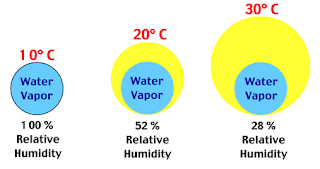Dew point and relative humidity are terms that show up frequently during TV weathercasts and on weather apps, but they can be confusing and misunderstood. These are the two main ways we describe the amount of moisture that's present in the atmosphere. They tell us how humid it is outside and help meteorologists determine if it will rain or not. Is one measure better than the other? Let's look at both a little closer to find out.
Relative Humidity
Relative humidity is a measure of the amount of water vapor in the air compared to the maximum amount of water vapor the air can hold at that temperature. It is always expressed as a percent. For example, say it's 60 degrees outside and the relative humidity is 50%. That means that the air is holding half the moisture it potentially could. If it's 60 degrees outside and the relative humidity is instead 100%, that means that the air is now holding the maximum amount of moisture it can, meaning the air is saturated.
The warmer the air, the more moisture it can hold. This means that the temperature of the air is critical in calculating relative humidity. The graphic below is very helpful in understanding this. The blue ball represents the actual water vapor present in the air and the yellow ball represents the maximum amount of water vapor air at that temperature could hold. Even if the amount of water vapor in the air doesn't change, the relative humidity will change if the air temperature changes.
The relative humidity can change dramatically in just one day, with lower values appearing in the afternoon when temperatures are higher, and higher values appearing at night when air temperatures are lower. This is why you have to be careful when looking at relative humidity values. Relative humidity is helpful for seeing how close air is to being saturated, but it really isn't a good measure of how humid it feels outside. If there isn't much moisture in the atmosphere but the temperature is low enough, you can get a high relative humidity, but it really won't feel humid outside. Because of this, meteorologists prefer to look at dew point temperatures to measure how much water vapor is in the air.
Dew Point
The dew point is the temperature at which air will become saturated. Below this temperature, condensation will begin to occur and dew will form on the surface of objects. Think about a can of soda you just took out of the refrigerator. The can is dry when you're inside, but as soon as you go outside on a humid day, little drops of water (dew) form on the outside of the can. The can is so cold that it has caused the water vapor in the air right around it to condense into liquid form. This means the temperature of the can is at or below the dew point temperature of the air.
The dew point temperature is dependent on the amount of water vapor in the air and will usually be lower than the current air temperature and will never be higher than it. When the dew point and air temperature are the same, the air will be saturated and the relative humidity will be 100%.
How humid will it feel at certain dew points? A dew point below 45 is considered low and represents dry air. Dew points between 45 and 65 represent moderate amounts of moisture and feel comfortable. Once the dew point climbs above 65 degrees, you will likely start to notice that it feels muggy and humid outside. Should the dew point climb into the 70s, you'll likely start hearing the bad hair day talk start up! If you keep these values in mind, you should have a much better grasp of how humid it is outside when you see a dew point temperature listed.
So while relative humidity is a good measure of how close we are getting to the dew point, it's the actual dew point temperatures that really tell us the moisture content of the air. Even though we all like percentages, try to use dew point instead of relative humidity to determine how humid it is outside. Trust me, you'll make any meteorologist a little happier if you ask them what the dew point is instead of the relative humidity :)
